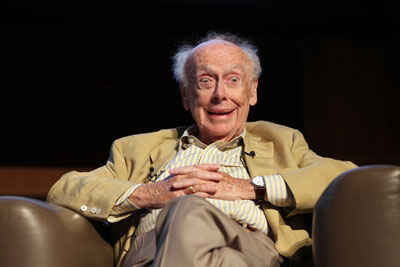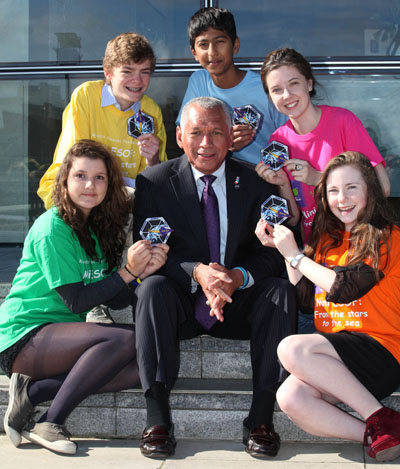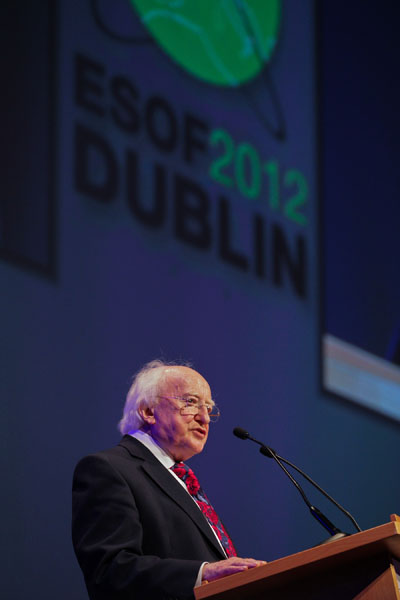Dr Subra Suresh, director of the US National Science Foundation
Dr Subra Suresh, who heads up the US National Science Foundation, is in Dublin this week for the Euroscience Open Forum. Tomorrow he will be signing a memorandum with the EU Commissioner for Research, Innovation and Science Máire Geoghegan-Quinn, but today he spoke to Siliconrepublic.com about investing in science and technology and the setting up of a virtual global entity called the Global Research Council for the heads of science funding agencies from around the world.
Suresh, an engineer and professor, has directed the US National Science Foundation since October 2010 after President Barack Obama nominated him.
Before taking up the role, Suresh served as the dean of the School of Engineering and the Vannevar Bush professor of engineering at MIT.
He has co-authored more than 240 journal articles and registered 21 patents.
Speaking today, Suresh started off by describing his role and mission at the US National Science Foundation (NSF).
“NSF has a budget of a little more of US$7bn a year. Our mandate is to fund all fields of science and engineering, including social, behavioural and economic sciences.”
He said the only area where the NSF does not have a key role is in biomedical research. “We don’t do clinical research that’s directly related to human health. That’s the domain of the National Institute of Health. But, having said that, we do have large activities in biological sciences, including genetics and agricultural sciences.”
He said his role would be equal to a CEO of a US$7bn company.
Funding areas
The NSF itself receives funding from the U.S Congress every year. Suresh said that all of the money goes back to the community, minus the foundation’s cost of doing business, which he said is currently less than 6pc.
“Last year we funded nearly 300,000 individuals in the US. These are professors, students, post-docs. We also fund community colleges, science museums, science programmes,” explained Suresh.
“We fund major facilities such as telescopes in Chile and Hawaii. We also run the Antarctica programme for the US Government. Plus we have ships that go across the oceans to do scientific research and we have supercomputing facilities that we fund.”
The NSF also funds the National Center for Atmospheric Research (NCAR) in Boulder Colorado, its largest funded centre. The NCAR develops computing models to predict weather patterns.

Nobel Laureate James Watson, on stage as part of the Euroscience Open Forum (ESOF) 2012. The American biologist, geneticist and zoologist is best known for being the a co-discoverer of the structure of DNA in 1953, along with Francis Crick. In 1962, Watson, Crick and Maurice Wilkins were awarded the Nobel Prize in physiology or Medicine
“Our mission is to fund the best ideas and the best people in every field of science and engineering. Part of that mission is not only to foster research but also to foster research into best educational practices. We are not in charge of implementing education – that’s the domain of the Department of Education,” said Suresh.
Human capital
However, he said that part of the NSF’s role, as the main funder of scientific enterprise in the US in all fields, it also does research into educational models and practices.
“It’s about human capital development to make sure we have enough of a supply of young scientists and engineers. We fund graduate research programmes, scholarships and faculty awards. These are human capital projects.
“We have to make sure that there’s an adequate supply of scientists so that the best science can be done.”

NASA administrator Charles F Bolden with some of the young people who attended his presentation in Dublin today. They include, from left: Julie Alexia Dias from Paris, Jack Doran from Clontarf, Dublin, Prithvi Narayana from Virginia in the US, Gemma Lyons from Lucan, Dublin and Orlaith Cullen from Co Laois
Global Research Council
Moving on to the setting up of the Global Research Council, Suresh said that the NSF organised an event around two months ago. “The idea was to bring together – perhaps for the first time – 46 countries, mainly G20 plus OCED countries, including Ireland.”
For instance, the head of Science Foundational Ireland Professor Mark Ferguson attended the convening.
“We also engaged other funding agencies from Washington. The idea was that this group very much was in charge of well over 90pc of all of the science and funding engineering in the world,” explained Suresh.
He said the goal was to bring this scientific group together to look at issues of collective interest and importance to move the dial significantly for science in the world.
The idea, said Suresh, was for the developed countries to talk about new issues and to help developing countries develop a scientific infrastructure
“By that I don’t mean just buildings and facilities, but also the concepts of scientific peer review, principles of research integrity, issues of intellectual property and mobility of young scientists and open access to publications and data.
‘Virtual’ global entity
“That’s why during the meeting we proposed to establish a virtual global entity called the Global Research Council.”
Suresh said this will be a ‘virtual group’ of heads of science funding agencies from around the world.
“That group will once a year get together. Leading up to that annual gathering, they will host many regional meetings. At the first meeting in Washington, we developed and endorsed principles of scientific peer review.
The next Global Research Council meeting will be co-hosted by Brazil and Germany in May 2013. It will be hosted in Berlin.
“They’ve taken up two topics: one is research integrity and the other one is about starting a conversation about public access to both publications and data.”
Accessing scientific data and the role of the internet
Suresh said the aim would be that sometime in the future scientists from all over the world will be able to access scientific data.
“Of course we all have issues of national security and proprietary information, but science by and large is an open entity and a highly global entity. So within the constraints in which we operate how can we create policies and different countries have different policies on open access.”
And he said the internet will have a role to play in the opening up of such scientific data, referring to how over half of scientific publications have authors from more than one country.
“Given the increasing globalisation of the scientific enterprise how do we make sure that all the things the science funding agencies do leads to greater collaboration while, of course, we compete for ideas and people.”
And he said that Ireland will continue to play a role with the Global Research Council.

Ireland’s President Michael D Higgins opens the Euroscience Open Forum in Dublin yesterday
Referring to his first trip to Ireland, Suresh said he was excited to see the word science mentioned in every part of the city.
“For the President of Ireland to come to speak at ESOF it sends out the right signal. I think Irish scientists are engaged in science all over the world and it is very nice to see Ireland host this Euroscience Open Forum. I think Ireland has a lot to offer the international science community.”
R&D investments globally
Finally, when asked about the role science and technology can play in helping global economies get back on the right economic paths, Suresh pointed to global R&D investments last year.
“It was approximately US$1.4trn. If you divide that geographically, around one-third of that was the US. About one-third was from Asia and slightly less than one-third was from the European Union.
“The Asian part is growing very significantly. It is a very interesting dynamic and I think what is new in the last one to two decades is large countries such as China and India have significantly increased their investments in R&D in the last decade or so. That’s creating a unique global dynamic.
“Given that, and given the highly international nature of science to begin with, and given the fact that we can collaborate much more easily through technology all over the globe in real-time, this is giving us a new opportunity to engage in science. This is one of the reasons why we thought there was a critical need for the Global Research Council,” he added.